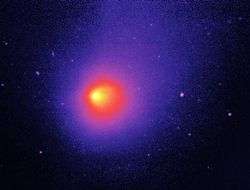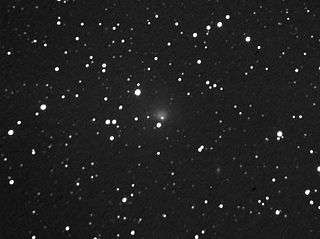29P/Schwassmann–Wachmann
 The comet Schwassmann–Wachmann 1 (Spitzer infrared image in false colours) Nasa | |
| Discovery | |
|---|---|
| Discovered by | Arno Arthur Wachmann |
| Discovery date | November 15, 1927 |
| Alternative designations |
1908 IV; 1927 II; 1941 VI; 1957 IV; 1974 II; 1989 XV; |
| Orbital characteristics A | |
| Epoch | March 6, 2006 |
| Aphelion | 6.25 AU |
| Perihelion | 5.722 AU |
| Semi-major axis | 5.986 AU |
| Eccentricity | 0.0441 |
| Orbital period | 14.65 a |
| Inclination | 9.3903° |
| Dimensions | 30.8 km[1] |
| Last perihelion | July 10, 2004[2] |
| Next perihelion | March 7, 2019[3][4] |
Comet 29P/Schwassmann–Wachmann, also known as Schwassmann–Wachmann 1, was discovered on November 15, 1927, by Arnold Schwassmann and Arno Arthur Wachmann at the Hamburg Observatory in Bergedorf, Germany.[5] It was discovered photographically, when the comet was in outburst and the magnitude was about 13.[5] Precovery images of the comet from March 4, 1902, were found in 1931 and showed the comet at 12th magnitude.[5]
The comet is unusual in that while normally hovering at around 16th magnitude, it suddenly undergoes an outburst. This causes the comet to brighten by 1 to 4 magnitudes.[6] This happens with a frequency of 7.3 outbursts per year,[6] fading within a week or two. The magnitude of the comet has been known to vary from 19th magnitude to 9th magnitude, a ten thousand-fold increase in brightness, during its brightest outbursts. Highly changing surface processes are suspected to be responsible for the observed behavior.[6]

The comet is thought to be a member of a relatively new class of objects called "centaurs", of which at least 80 are known. These are small icy bodies with orbits between those of Jupiter and Neptune. Astronomers believe that centaurs are recent escapees from the Kuiper belt, a zone of small bodies orbiting in a cloud at the distant reaches of the Solar System. Frequent perturbations by Jupiter[1] will likely accumulate and cause the comet to migrate either inward or outward by the year 4000.[9]
The dust and gas comprising the comet's nucleus is part of the same primordial materials from which the Sun and planets were formed billions of years ago. The complex carbon-rich molecules they contain may have provided some of the raw materials from which life originated on Earth.
The comet nucleus is estimated to be 30.8 kilometers in diameter.[1]
References
- 1 2 3 "JPL Close-Approach Data: 29P/Schwassmann-Wachmann 1" (last observation: April 10, 2009). Retrieved 2009-05-05.
- ↑ 29P past, present and future orbital elements
- ↑ Syuichi Nakano (January 29, 2012). "29P/Schwassmann-Wachman 1 (NK 2189)". OAA Computing and Minor Planet Sections. Retrieved 2012-02-18.
- ↑ Patrick Rocher (February 4, 2012). "Note number : 0015 P/Schwassmann-Wachmann 1 : 29P". Institut de mécanique céleste et de calcul des éphémérides. Retrieved 2012-02-18.
- 1 2 3 Kronk, Gary W. (2001–2005). "29P/Schwassmann-Wachmann 1". Archived from the original on October 22, 2008. Retrieved 2008-10-13. (Cometography Home Page)
- 1 2 3 Trigo-Rodríguez; Melendo; García-Hernández; Davidsson; Sánchez (2008). "A continuous follow-up of Centaurs, and dormant comets: looking for cometary activity." (PDF). European Planetary Science Congress. Retrieved 2008-10-13.
- ↑ Trigo-Rodriguez et al., Outburst activity in comets, I. Continuous monitoring of comet 29P/Schwassmann-Wachmann 1
- ↑ Trigo-Rodriguez et al., Outburst activity in comets , II. A multi-band photometric monitoring of comet 29P/Schwassmann-Wachmann 1
- ↑ "Twelve clones of 29P/Schwassmann-Wachmann diverging by the year 4000". Retrieved 2009-04-30. (Solex 10) Archived 2009-04-29 at WebCite
External links
- Orbital simulation from JPL (Java) / Ephemeris
- 29P at CometBase
- 29P at Las Cumbres Observatory (8 Feb 2010 12:23, 60 seconds)
- 29P (Joseph Brimacombe April 18, 2013)
| Numbered comets | ||
|---|---|---|
| Previous 28P/Neujmin |
29P/Schwassmann–Wachmann | Next 30P/Reinmuth |



